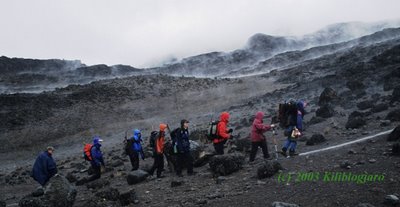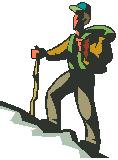Many people ask this about Kilimanjaro. When I answer “19,341 feet,” they nod their heads knowingly and continue the conversation. But what does climbing to 19,000 feet mean?
At 19,000 feet above sea level, there is less than half as much oxygen for your brain and muscles to utilize. That’s a pretty serious deficit.
If we were dropped off on the summit of Kilimanjaro by a helicopter, with no acclimatization, it would take only minutes to a few hours for us to start feeling the serious effects of altitude. Our lungs would start filling with fluid and our brains would swell until we were unconscious. Unless we immediately started to descend, either condition would eventually kill us.
This blog won’t go into the physiology of acclimatization, but it’s important to understand that there are two major things your body needs to acclimatize successfully: time and fitness.
Please note: Kiliblogjaro is not a doctor. This advice is necessarily general in nature and is not that of a medical professional. Please consult with a physician before undertaking a climb of Kilimanjaro or any high-altitude adventure.
Time is of the essence

Time is the single most important factor for acclimatization. As a guide, I won’t offer a Kilimanjaro climb taking fewer than seven days.
An old rule of thumb in mountaineering is to raise your sleeping elevation no more than 1,000 vertical feet for each day spent above 10,000 feet. Since Kilimanjaro’s high camps are all around 16,000 feet, it would take eight or nine days to follow this rule exactly (note: most trips that take eight or nine days include a “crater camp” at 18,000 feet, which then breaks the rule again!).
Time is money on Kilimanjaro, with park fees now at more than US$100 per climber per day. Thus, a favorite way for cut-rate outfitters to keep their prices low is by trying to book climbers on a five- or six-day climb. It might seem tempting, as spending only five or six days on the mountain leaves you with more time and money to spend on the rest of your vacation. This option might seem especially tempting if you are in good physical condition and the distances seem short.
But beware! The less time you spend climbing up the mountain, the worse you will feel on top.
Slowly but surely
So the key to climbing Kilimanjaro is to climb slowly. Fair enough. There is one other consideration: your fitness going into the climb.
Fitness is important for obvious reasons (you couldn’t climb up a hill without it, right?), but it’s also critical to acclimatization because acclimatization is physically taxing.
As you move to higher elevations, your resting pulse and respiration accelerate. Your body is straining to adjust to the new conditions of elevation and reduced oxygen. This puts a serious strain on your body-so if you are in good condition before you start the climb, this will help your acclimatization.
While you’re climbing, it’s important to help your body along by staying well hydrated and fed. It’s amazing how easy it is to forget a basic thing like drinking plenty of fluids while you’re worried about climbing a mountain!
 The drug question
The drug questionA number of climbers place stock in herbal remedies; ginko biloba appears to have some promise as an herb with measurable effect in acclimatization. There are also some drugs available by prescription, most notably Diamox (generic: acetazolamide).
Like most drugs, there is a tradeoff with acetazolamide. It does help with acclimatization and in the prevention of altitude sickness, but it is also a diuretic. If you take acetazolamide, you’ll have to double your efforts to stay hydrated and will almost certainly have to get up a couple times each night.
Some users report other unpleasant side effects with acetazolamide, specifically tingling and numbness in the hands and feet.
Another drug, dexamethasone, is a prescription-only drug for cerebral edema. Unlike acetazolamide, it cannot be taken prophylactically (as a preventative).


